Input data
Well as you did not shared the original input data in numerical form I extracted it from the images. This part is meant for others... First I edited them in paint a bit:
fill the background by Black color
that removes many of the bi tangent points
crop inside
that removes axises and scales/grid
manually clear the remnant pixels of what has been left from the bitangent
Then I apply some DIP to shrink all vertical and horizontal lines to single point here the results:


and then I extracted xy of any non background pixels (first number is x, second y in pixels):
int data0_xy[]=
{
33, 447, 41, 451, 49, 462, 56, 470, 64, 473, 72, 477, 80, 481, 87, 489, 95, 492, 103, 495, 111, 496, 118, 500, 126, 504, 134, 507, 142, 506, 149, 506,
157, 510, 165, 514, 173, 512, 180, 512, 188, 512, 196, 515, 204, 515, 212, 513, 219, 512, 227, 514, 235, 514, 243, 513, 250, 512, 258, 511, 266, 512, 274, 511,
281, 508, 289, 505, 297, 505, 305, 506, 312, 505, 320, 500, 328, 500, 336, 500, 343, 501, 351, 497, 359, 495, 367, 497, 374, 499, 382, 500, 390, 498, 398, 498,
406, 501, 413, 502, 421, 501, 429, 501, 437, 502, 444, 504, 452, 506, 460, 504, 468, 504, 475, 504, 483, 505, 491, 505, 499, 503, 506, 500, 514, 501, 522, 503,
530, 499, 537, 497, 545, 495, 553, 496, 561, 495, 569, 490, 576, 486, 584, 486, 592, 485, 600, 483, 607, 478, 615, 475, 623, 472, 631, 471, 638, 468, 646, 461,
654, 457, 662, 454, 669, 452, 677, 450, 685, 443, 693, 436, 700, 431, 708, 429, 716, 425, 724, 417, 732, 410, 739, 405, 747, 400, 755, 397, 763, 387, 770, 380,
778, 375, 786, 369, 794, 363, 801, 355, 809, 346, 817, 342, 825, 336, 832, 326, 840, 318, 848, 310, 856, 306, 863, 300, 871, 291, 879, 281, 887, 274, 894, 269,
902, 263, 910, 252, 918, 244, 926, 237, 933, 230, 941, 224, 949, 215, 957, 206, 964, 202, 972, 197, 980, 187, 988, 179, 995, 173,1003, 169,1011, 162,1019, 155,
1026, 148,1034, 141,1042, 136,1050, 133,1057, 126,1065, 119,1073, 115,1081, 113,1089, 108,1096, 102,1104, 97,1112, 97,1120, 94,1127, 87,1135, 84,1143, 82,
1151, 84,1158, 80,1166, 77,1174, 74,1182, 72,1189, 73,1197, 72,1205, 69,1213, 67,1220, 68,1228, 68,1236, 64,1244, 62,1252, 61,1259, 63,1267, 60,
1275, 57,1283, 53,1290, 49,1298, 49,1306, 47,1314, 40,1321, 35,1329, 31,1337, 27,1345, 20,1352, 10,
};
int data1_xy[]=
{
33, 533, 41, 533, 49, 532, 56, 531, 64, 533, 72, 532, 80, 530, 87, 533, 95, 530, 103, 533, 111, 531, 118, 532, 126, 531, 134, 531, 142, 531, 149, 529,
157, 530, 165, 530, 173, 529, 180, 526, 188, 529, 196, 527, 204, 525, 212, 526, 219, 526, 227, 525, 235, 523, 243, 520, 250, 522, 258, 520, 266, 520, 274, 517,
281, 519, 289, 516, 297, 515, 305, 513, 312, 511, 320, 510, 328, 509, 336, 507, 343, 503, 351, 503, 359, 501, 367, 500, 374, 496, 382, 496, 390, 493, 398, 490,
406, 488, 413, 485, 421, 482, 429, 480, 437, 476, 444, 469, 452, 467, 460, 466, 468, 461, 475, 456, 483, 451, 491, 449, 499, 442, 506, 438, 514, 432, 522, 426,
530, 420, 537, 411, 545, 402, 553, 400, 561, 395, 569, 386, 576, 380, 584, 372, 592, 363, 600, 354, 607, 344, 615, 336, 623, 327, 631, 323, 638, 315, 646, 300,
654, 299, 662, 291, 669, 284, 677, 273, 685, 266, 693, 256, 700, 250, 708, 243, 716, 237, 724, 227, 732, 217, 739, 210, 747, 197, 755, 185, 763, 184, 770, 151,
778, 165, 786, 158, 794, 145, 801, 136, 809, 111, 817, 119, 825, 112, 832, 105, 840, 94, 848, 76, 856, 80, 863, 78, 871, 66, 879, 60, 887, 40, 894, 28,
902, 38, 910, 42, 918, 41, 926, 46, 933, 47, 941, 41, 949, 42, 957, 39, 964, 48, 972, 52, 980, 49, 988, 57, 995, 51,1003, 67,1011, 78,1019, 85,
1026, 90,1034, 96,1042, 106,1050, 114,1057, 123,1065, 132,1073, 126,1081, 137,1089, 157,1096, 169,1104, 175,1112, 169,1120, 189,1127, 191,1135, 204,1143, 209,
1151, 221,1158, 229,1166, 235,1174, 226,1182, 241,1189, 244,1197, 257,1205, 264,1213, 260,1220, 273,1228, 275,1236, 280,1244, 285,1252, 288,1259, 290,1267, 292,
1275, 290,1283, 297,1290, 298,1298, 298,1306, 301,1314, 300,1321, 304,1329, 304,1337, 298,1345, 297,1352, 297,
};
So now we have more or less the same data as you do...
Bitangent
Well as your data is not that big you can try bruteforce approach.
loop through all point pairs
simple O(n^2) search. Do not test point pairs twice so the second loop will not test points already done in first loop.
detect if valid bitangent
so if we compute normal vector to tested bitangent (perpendicular vector to it pointing towards data points). Then all the vectors p(i)-p(bitangent) must have non negative (or positive if you want exactly 2 hits) dot product with our normal. This lead to another O(n) loop resulting in O(n^3) approach. If any dot product crosses zero throw away this bitangent and test the next one. If no dot product crosses you found bitangent so add the actaul points from first two loops as a new bitangent to the list.
This will find all the bitangents on the lowwer side of data (or above it if you flip the normal vector or crossing condition). So now you can apply your heuristics to select bitangent you want.
I do not code in C# so here simple C++ example:
const int n2=sizeof(data_xy)/sizeof(data_xy[0]); // numbers in data
const int n=n2>>1; // points in data
int bitangent[100],bitangents; // 2 poit indexes per bitangent, number of indexes in bitangent[]
// O(n^3) bruteforce bitangent search
int nx,ny,i2,j2,k2,dx,dy;
bitangents=0;
for (i2=0;i2<n2;i2+=2) // loop all points (bitangent start)
for (j2=i2+2;j2<n2;j2+=2) // loop all yet untested points (bitangent end)
{
// normal
ny=-(data_xy[j2+0]-data_xy[i2+0]);
nx=+(data_xy[j2+1]-data_xy[i2+1]);
// test overlap
for (k2=0;k2<n2;k2+=2)
if ((k2!=i2)&&(k2!=j2))
{
dx=data_xy[k2+0]-data_xy[i2+0];
dy=data_xy[k2+1]-data_xy[i2+1];
if ((dx*nx)+(dy*ny)<0) { k2=-1; break; } // if dot product is negative overlap occurs so throw solution away
}
if (k2>=0)
{
bitangent[bitangents]=i2; bitangents++;
bitangent[bitangents]=j2; bitangents++;
}
}
I render like this (VCL):
void draw()
{
int i2,j2,x,y,r=3;
bmp->Canvas->Brush->Color=clWhite;
bmp->Canvas->FillRect(TRect(0,0,xs,ys));
// render data lines
bmp->Canvas->Pen->Color=clBlack;
for (i2=0;i2<n2;i2+=2)
{
x=data_xy[i2+0];
y=data_xy[i2+1];
if (!i2) bmp->Canvas->MoveTo(x,y);
else bmp->Canvas->LineTo(x,y);
}
// render bitangents lines
bmp->Canvas->Pen->Color=clBlue;
for (i2=0;i2<bitangents;i2+=2)
{
j2=bitangent[i2+0];
x=data_xy[j2+0];
y=data_xy[j2+1];
bmp->Canvas->MoveTo(x,y);
j2=bitangent[i2+1];
x=data_xy[j2+0];
y=data_xy[j2+1];
bmp->Canvas->LineTo(x,y);
}
// render data points
bmp->Canvas->Pen->Color=clBlack;
bmp->Canvas->Brush->Color=clRed;
for (i2=0;i2<n2;i2+=2)
{
x=data_xy[i2+0];
y=data_xy[i2+1];
bmp->Canvas->Ellipse(x-r,y-r,x+r,y+r);
}
// render bitangents points
bmp->Canvas->Pen->Color=clBlack;
bmp->Canvas->Brush->Color=clAqua;
for (i2=0;i2<bitangents;i2++)
{
j2=bitangent[i2];
x=data_xy[j2+0];
y=data_xy[j2+1];
bmp->Canvas->Ellipse(x-r,y-r,x+r,y+r);
}
Form1->Canvas->Draw(0,0,bmp);
}
And here output for your data:


As you can see I did not need any floating point operation or variable :) To keep this as simple as possible I used static arrays (no dynamic allocation). As you can see there are quite more bitangents than you think at first.





